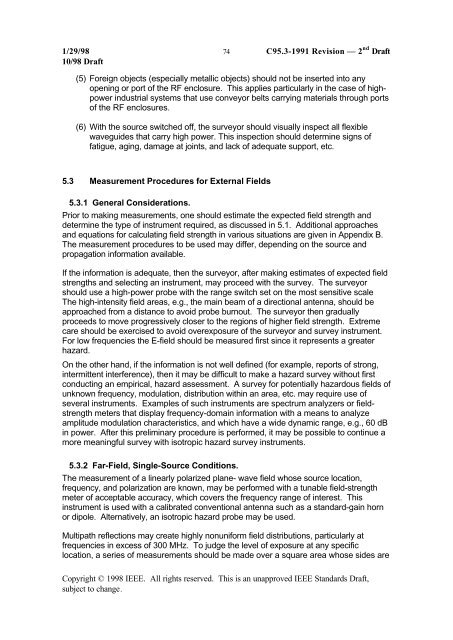DRAFT Recommended Practice for Measurements and ...
DRAFT Recommended Practice for Measurements and ...
DRAFT Recommended Practice for Measurements and ...
Create successful ePaper yourself
Turn your PDF publications into a flip-book with our unique Google optimized e-Paper software.
1/29/98 74 C95.3-1991 Revision — 2 nd Draft<br />
10/98 Draft<br />
(5) Foreign objects (especially metallic objects) should not be inserted into any<br />
opening or port of the RF enclosure. This applies particularly in the case of highpower<br />
industrial systems that use conveyor belts carrying materials through ports<br />
of the RF enclosures.<br />
(6) With the source switched off, the surveyor should visually inspect all flexible<br />
waveguides that carry high power. This inspection should determine signs of<br />
fatigue, aging, damage at joints, <strong>and</strong> lack of adequate support, etc.<br />
5.3 Measurement Procedures <strong>for</strong> External Fields<br />
5.3.1 General Considerations.<br />
Prior to making measurements, one should estimate the expected field strength <strong>and</strong><br />
determine the type of instrument required, as discussed in 5.1. Additional approaches<br />
<strong>and</strong> equations <strong>for</strong> calculating field strength in various situations are given in Appendix B.<br />
The measurement procedures to be used may differ, depending on the source <strong>and</strong><br />
propagation in<strong>for</strong>mation available.<br />
If the in<strong>for</strong>mation is adequate, then the surveyor, after making estimates of expected field<br />
strengths <strong>and</strong> selecting an instrument, may proceed with the survey. The surveyor<br />
should use a high-power probe with the range switch set on the most sensitive scale<br />
The high-intensity field areas, e.g., the main beam of a directional antenna, should be<br />
approached from a distance to avoid probe burnout. The surveyor then gradually<br />
proceeds to move progressively closer to the regions of higher field strength. Extreme<br />
care should be exercised to avoid overexposure of the surveyor <strong>and</strong> survey instrument.<br />
For low frequencies the E-field should be measured first since it represents a greater<br />
hazard.<br />
On the other h<strong>and</strong>, if the in<strong>for</strong>mation is not well defined (<strong>for</strong> example, reports of strong,<br />
intermittent interference), then it may be difficult to make a hazard survey without first<br />
conducting an empirical, hazard assessment. A survey <strong>for</strong> potentially hazardous fields of<br />
unknown frequency, modulation, distribution within an area, etc. may require use of<br />
several instruments. Examples of such instruments are spectrum analyzers or fieldstrength<br />
meters that display frequency-domain in<strong>for</strong>mation with a means to analyze<br />
amplitude modulation characteristics, <strong>and</strong> which have a wide dynamic range, e.g., 60 dB<br />
in power. After this preliminary procedure is per<strong>for</strong>med, it may be possible to continue a<br />
more meaningful survey with isotropic hazard survey instruments.<br />
5.3.2 Far-Field, Single-Source Conditions.<br />
The measurement of a linearly polarized plane- wave field whose source location,<br />
frequency, <strong>and</strong> polarization are known, may be per<strong>for</strong>med with a tunable field-strength<br />
meter of acceptable accuracy, which covers the frequency range of interest. This<br />
instrument is used with a calibrated conventional antenna such as a st<strong>and</strong>ard-gain horn<br />
or dipole. Alternatively, an isotropic hazard probe may be used.<br />
Multipath reflections may create highly nonuni<strong>for</strong>m field distributions, particularly at<br />
frequencies in excess of 300 MHz. To judge the level of exposure at any specific<br />
location, a series of measurements should be made over a square area whose sides are<br />
Copyright © 1998 IEEE. All rights reserved. This is an unapproved IEEE St<strong>and</strong>ards Draft,<br />
subject to change.
















